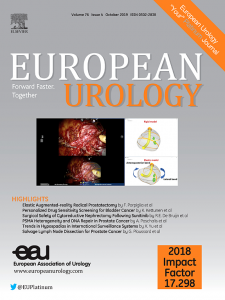Erectile Dysfunction: Update on Clinical Management
IF 25.3
1区 医学
Q1 UROLOGY & NEPHROLOGY
引用次数: 0
Abstract
Background and objective
Erectile dysfunction (ED) is a common condition affecting patients’ quality of life. Clinical management has changed over the past three decades, with new diagnostic and therapeutic options available. Our aim was to provide an overview of novel evidence regarding clinical management of ED.Methods
A non-systematic literature review was conducted to identify relevant studies on the diagnosis and treatment of erectile dysfunction. The review encompassed pharmacological, regenerative, and surgical approaches, summarising recent advances and highlighting persisting gaps in clinical practice.Key findings and limitations
ED is a common reason for seeking medical consultation. The correlation between ageing and ED prevalence is rooted in neurovascular tissue impairment. Medical history, along with the use of validated questionnaires, still represents the mainstay of ED assessment because of the lack of reliable imaging tests. The most widely used and effective treatment is an oral phosphodiesterase type 5 inhibitor, but this is lifelong therapy that is associated with high dropout rates. Among novel regenerative treatments, low-intensity shockwave therapy is supported by more evidence, although high-quality trials and long-term data are lacking. More conclusive evidence is needed for platelet-rich plasma injections and stem cell treatment. Botulinum neurotoxin and new emerging oral drugs are also under investigation.Conclusions
Several treatment options are available for ED. Clinical tailoring of treatment for individual patients and rigorous research are crucial for further advances.Patient summary
Erectile dysfunction (ED) is a common medical problem. Various types of treatment can improve ED, but there is still no cure for this condition.勃起功能障碍:最新的临床管理
背景与目的勃起功能障碍(ED)是影响患者生活质量的常见疾病。在过去的三十年中,临床管理发生了变化,有了新的诊断和治疗选择。我们的目的是概述ed临床治疗的新证据。方法进行非系统的文献回顾,以确定勃起功能障碍的诊断和治疗的相关研究。该综述包括药理学、再生和外科入路,总结了最近的进展,并强调了临床实践中持续存在的差距。主要发现和局限性sed是寻求医疗咨询的常见原因。衰老与ED患病率之间的相关性根植于神经血管组织损伤。由于缺乏可靠的影像学检查,病史和有效问卷的使用仍然是ED评估的主要依据。最广泛使用和最有效的治疗方法是口服磷酸二酯酶5型抑制剂,但这是一种终身治疗,与高辍学率有关。在新的再生疗法中,低强度冲击波疗法得到了更多证据的支持,尽管缺乏高质量的试验和长期数据。富血小板血浆注射和干细胞治疗还需要更确凿的证据。肉毒杆菌神经毒素和新出现的口服药物也在调查之中。结论ED有多种治疗方案,临床个体化治疗和严格的研究是进一步发展的关键。患者总结:勃起功能障碍(ED)是一个常见的医学问题。各种治疗方法都可以改善ED,但目前还没有根治这种疾病的方法。
本文章由计算机程序翻译,如有差异,请以英文原文为准。
求助全文
约1分钟内获得全文
求助全文
来源期刊

European urology
医学-泌尿学与肾脏学
CiteScore
43.00
自引率
2.60%
发文量
1753
审稿时长
23 days
期刊介绍:
European Urology is a peer-reviewed journal that publishes original articles and reviews on a broad spectrum of urological issues. Covering topics such as oncology, impotence, infertility, pediatrics, lithiasis and endourology, the journal also highlights recent advances in techniques, instrumentation, surgery, and pediatric urology. This comprehensive approach provides readers with an in-depth guide to international developments in urology.
 求助内容:
求助内容: 应助结果提醒方式:
应助结果提醒方式:


